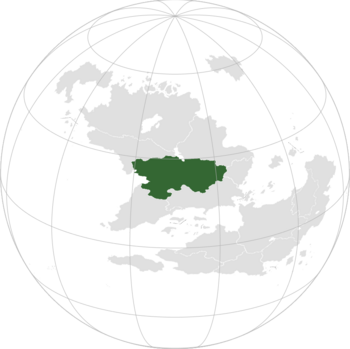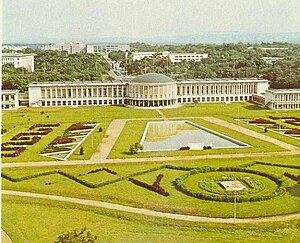User:Mu/Sandbox 4
Federal Republic of Kambara | |
|---|---|
| Motto: "Audeamus" (Latin) "Let us dare" | |
| Anthem: Kiapo cha Kitaifa (Kambari) The National Oath | |
 PLACEHOLDERMAP of Kambara in Bahia | |
| Capital | Chengoni |
| Largest city | Kiandongoro |
| Official languages | Kambari Gaullican |
| Recognised regional languages | Kinyakanyunwe Estmerish Mehare |
| Ethnic groups (2010) | 25% Kariko 17% Kayunsenyi 15% Maang'u 12% Akala 10% Sibuye 9% Mtongwe 8% Other Bahian 4% Non-Bahian |
| Religion (2014) | |
| Demonym(s) | Kambari |
| Government | Federal semi-presidential multi-party republic |
| Hodari Mshindi (UMK) | |
| Habib Abdu (CM) | |
| Mwinyi Salehe (UMK) | |
| Legislature | National Assembly |
| Assembly of Peers | |
| Assembly of Experts | |
| Transfer from Gaullica to the Community of Nations | |
| 1935 | |
| 1950 | |
| 1955-1971 | |
| 1988-2000 | |
| 2000 | |
| 2001 | |
| Population | |
• 2010 census | 30,857,293 |
| GDP (PPP) | 2010 estimate |
• Total | $129.60 billion |
• Per capita | $4,200.00 |
| GDP (nominal) | 2010 estimate |
• Total | $92.57 billion |
• Per capita | $3,000.00 |
| Gini (2010) | high |
| HDI (2010) | medium |
| Currency | Kambari sarathamani |
| Time zone | UTC+215 |
| Date format | dd-mm-yyyy CE |
| Driving side | right |
| Calling code | KBA |
| Internet TLD | .kba |
Kambara (/kæmbɑːrɑː/), known formally as the Federal Republic of Kambara (Kambari: Shirikisho la Jamhuri ya Kambara; Gaullican: République Fédérale de Kambara) is a sovereign nation located along the northern coast of Bahia on the mainland of the continent of Coius. It borders Habasha to the south, Kaiye Tourie to the southwest, NULL to the north, NULL to the west, and the Vehemens Ocean to the east. It also maintains jurisdiction over the island of Kisulaba, which lies within the Vehemens Ocean itself. Kambara has an estimated population of roughly 30,857,293 people, the XXth highest in Coius and the XXth largest in the world. It has a total area of roughly XXXkm2 (XXXsqmi), making it the XXth largest in Coius and the XXth largest in the world. Its capital is the planned city of Chengoni, while its largest city is Kiandongoro.
Evidence of primate habitation has been recorded in the region since roughly 15 million years ago, with skeletal evidence of early hominids dating back dating back at least 2 million years, and hunter-gatherers inhabiting the region at least 400,000 BCE. The first 'nation' appeared around the year 1 BCE, when a series of early city-states united to form the Kisaoni Kingdom, located in the xxx region of Kambara.
Early civilization WIP - Chathoro Empire forms by 1200 CE
The region was colonized by Gaullica as part of TERRITORYNAME during the scramble for Bahia in the early 18th and 19th-centuries. The region would continue to be a critical part of Gaullican administration in Bahia, with many Kambari being conscripted to serve in indigenous units administering the region. TERRITORYNAME also fought on the side of Gaullica and the Entente as part of the Great War, with the region eventually falling to XXXX in 193X. In the aftermath of the Great War and the formation of the Community of Nations the region was designated as Kambiland, a Community of Nation trustee, in 1935. The region was then ruled jointly by CoNNATIONS via the Trusteeship Council of Kambiland until sovereignty was transferred to the local Kambari people via the Treaty of Kesselbourg City in 1950.
Ethnic, religious, and ideological tensions within the country began to boil over, known as the Kamburi Emergency, with the country seeing nearly half a dozen governments and governing coalitions come and go by 1960. That year the Kamburi military forced the government to call snap elections which saw the rigged election of Hodari Badru. Badru, an ardent Bahian socialist, would wield dictatorial powers and quash all dissent within the country and successfully end the Kamburi Emergency by 1971. Elections in 1972 would see the rise of Badru ally Sefu Simba who would serve, in much the same manner as his predecessor, until his assassination by ethnic Kayunsenyi dissidents in 1988. Leading to the military to appoint Gen. Shomari Khalfani as president, Khalfani would then declare martial law over the country and use both military and paramilitary forces to engage in a 12 year ethnic cleansing campaign against the Kayunsenyi and Mtongwe people. This war would last until 2000 when, under sanction by the Community of Nations and threatened with regime change, Khalfani was forced to sign the XXX Accords. The treaty mandated the resignation of Khalfani and his government, the internationally observed end of the war, the demobilization and disarmament paramilitary groups, and constitutional amendments ensuring a transition to democracy. While the accords were largely successful, it failed to secure many institutional changes safeguarding democracy in the country.
The country has been ruled by the National Liberation Front (Kambari: Ukombozi wa Mbele wa Kitaifa; UMK) and Abasi Busara, longtime political successor to Shomari Khalfani, since 2001. The country is a federal semi-presidential multi-party republic where the National Liberation Front has control over both positions of head of state and head of government (though the Kayunsenyi and Mtongwe-dominated Party for Progress (Kambari: Chama cha Maendeleo; CM) controls the Vice Presidency as part of a power-sharing deal). The country has been called a flawed democracy due to the extensive controls the UMK has over the legislative and legal system, Kamburi society, and the media. Additionally, there is a lack of legitimate political opposition, with much of the CM and National Jubilee Association (Kambari: Chama cha Jubilee cha Kitaifa; CJK) being considered controlled opposition.
ORGANIZATIONS WIP
History
Pre-History
Early History and Colonization
Gaullican rule and Great War

Community of Nations Trust Territory
Full Independence and Kambari Emergency
1972 elections and the War in Bushamba
XXX Accords and Contemporary Era





